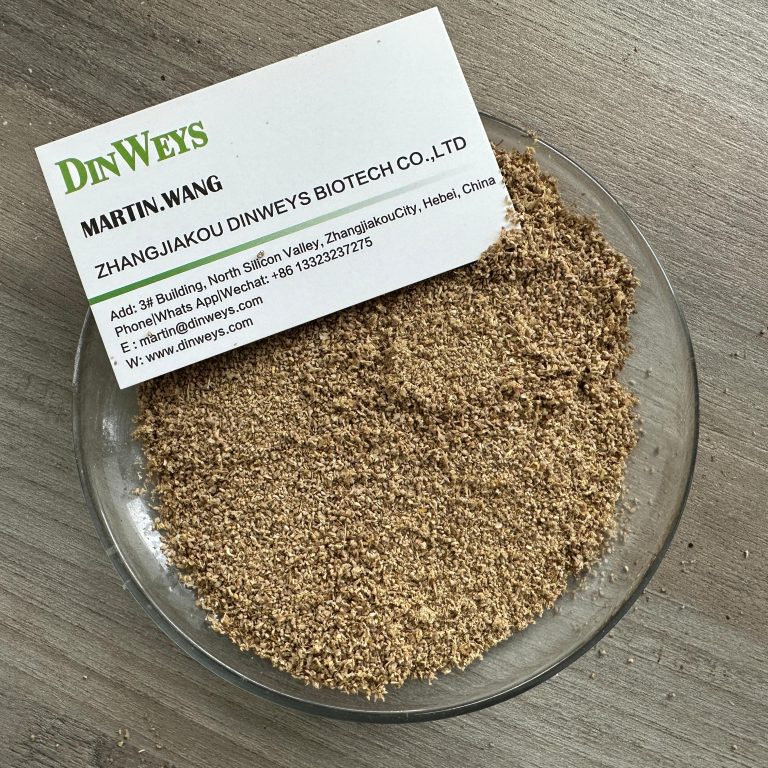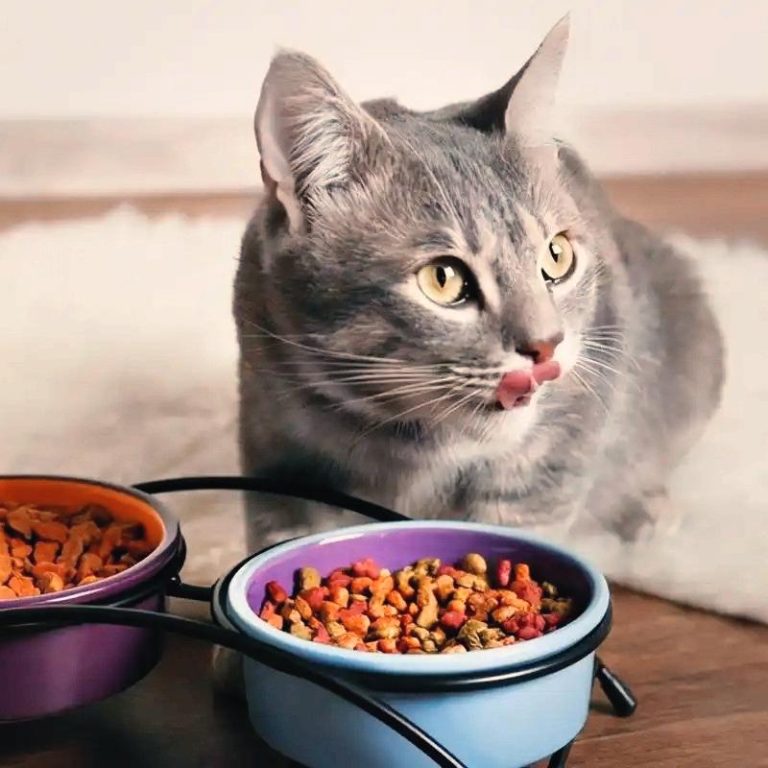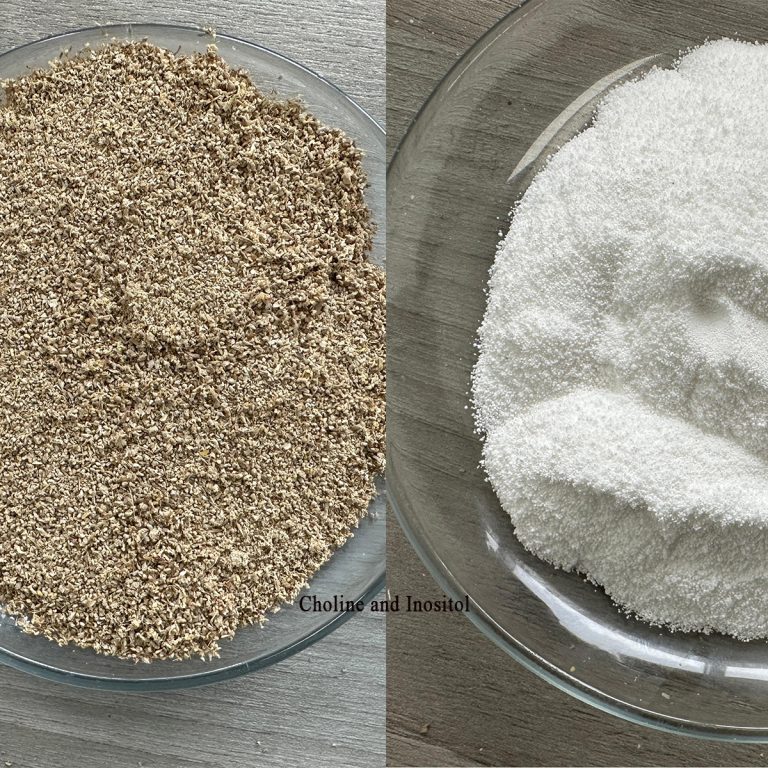Introduction
Choline chloride is one of the most widely used nutritional additives in both livestock and companion animal nutrition. It belongs to the B-complex vitamin family, and choline plays a vital role in maintaining dogs’ cellular health, lipid metabolism, and neurological function. In the context of pet nutrition—particularly dog food—choline chloride is considered a fundamental additive for balanced formulations. Here, we will show you an in-depth analysis of the properties, functions, alternatives, and considerations of choline chloride in dog food.
1. What Is Choline Chloride?
Choline chloride (C₅H₁₄ClNO) is the chloride salt of choline, a water-soluble quaternary ammonium compound. In its pure form, it appears as a white crystalline powder or as a colorless hygroscopic liquid. Commercially, it is often supplied in powder, liquid, or coated formulations, usually mixed with carriers like corn cob or silica to improve stability.
Odor and taste: Choline chloride has a slightly fishy odor and a salty-bitter taste, typical of amines.
Stability: It is highly hygroscopic and prone to caking, which is why stabilized or coated versions are preferred in feed formulations.
Other choline-related products used in animal nutrition include:
Choline bitartrate – less hygroscopic.
Phosphatidylcholine (lecithin) – a natural form of choline found in soy or egg yolk.
Choline citrate – occasionally used in veterinary medicine.
2. Why Add Choline Chloride to Dog Food?
Dogs, like humans, require choline for multiple physiological processes. Although choline can be synthesized in the liver to some extent, endogenous production is insufficient to meet metabolic demands, especially in growth, reproduction, or stress conditions (Zeisel & da Costa, 2009).
Key roles of choline in dog food:
Lipid metabolism and liver protection: Choline prevents fat accumulation in the liver by supporting the synthesis of phosphatidylcholine, essential for very low-density lipoprotein (VLDL) formation. Without adequate choline, dogs may develop hepatic lipidosis.
Neurotransmitter synthesis: Choline is a precursor to acetylcholine, a neurotransmitter critical for memory, muscle control, and nerve signaling.
Cell membrane structure: As a component of phospholipids, choline is indispensable for cell integrity and signaling.
Methyl donor function: Choline acts as a methyl donor in homocysteine metabolism, supporting cardiovascular and neurological health.
For these reasons, AAFCO (Association of American Feed Control Officials) lists choline as an essential nutrient for dogs, with minimum requirements set in complete and balanced pet foods.
3. Alternatives to Choline Chloride in Dog Food
While choline chloride remains the most economical and concentrated source of choline, alternative forms exist:
Lecithin (phosphatidylcholine): A natural lipid-based source, less irritating and more palatable, but less concentrated.
Choline bitartrate: Common in human supplements, provides moderate bioavailability.
Methionine and betaine: Indirect substitutes, since they also function as methyl donors, though they cannot fully replace choline’s structural roles.
Manufacturers may partially replace choline chloride with these alternatives when formulating specialized diets (e.g., sensitive stomach formulas or liver-support diets).
4. Use of Choline Chloride in Other Animal Feeds
Choline chloride is not exclusive to dog food. It is widely applied across the animal nutrition industry:
Poultry: To prevent fatty liver syndrome, enhance growth, and improve feed efficiency.
Swine: Supports reproductive performance and carcass quality.
Aquaculture: Essential for fish growth and osmoregulation.
Ruminants: Though rumen microbes can degrade free choline, protected forms (rumen-protected choline) are used to support dairy cow milk production.
This wide application demonstrates its critical role as a universal nutrient in animal husbandry (Sharma et al., 2018).
5. Benefits and Drawbacks of Choline Chloride in Dog Food
| Aspect | Benefits | Drawbacks |
|---|---|---|
| Bioavailability | Highly concentrated and efficient choline source | Hygroscopic and unstable in pure form |
| Cost | Economical compared to lecithin or choline bitartrate | Quality varies depending on formulation |
| Physiological Impact | Supports liver health, growth, and nerve function | Excess supplementation may cause a fishy odor in breath/urine |
| Formulation | Compatible with most dry pet food processes | Sensitive to heat, may degrade in extrusion if not protected |
6. Can Pet Owners Add Choline Chloride in Dog Food at Home?
While theoretically possible, adding choline chloride directly to homemade diets is not recommended without veterinary or nutritionist supervision.
Reasons:
Risk of overdose: Excessive choline intake may cause gastrointestinal upset, hypotension, or trimethylaminuria (“fishy odor syndrome”).
Measurement challenges: Commercial formulations use precise equipment to ensure correct dosing (typically in mg/kg of body weight).
Regulatory guidance: Only AAFCO-compliant pet foods guarantee proper nutrient levels.
Practical advice for homemade dog diets:
Consult a veterinary nutritionist before supplementation.
Consider safer choline sources such as egg yolk, liver, soybean lecithin, or poultry meat.
The End
Choline chloride in dog food is important, ensuring dogs receive adequate choline to support liver function, neurological health, and metabolic processes. While economical and effective, it has limitations in stability and palatability. Alternatives such as lecithin or choline bitartrate exist but are less commonly used due to cost considerations. For pet owners, the best approach is to rely on balanced, commercial dog foods rather than attempting unsupervised supplementation.
By understanding the role of choline chloride, dog owners and professionals can make informed choices about dietary formulations and appreciate the science behind complete pet nutrition.
References
National Research Council (NRC). (2006). Nutrient Requirements of Dogs and Cats. Washington, DC: National Academies Press.
Sharma, R., Kumar, V., & Kumar, A. (2018). Importance of choline in animal nutrition: A review. International Journal of Livestock Research, 8(9), 1-14.
Zeisel, S. H., & da Costa, K. A. (2009). Choline: An essential nutrient for public health. Nutrition Reviews, 67(11), 615–623.
Association of American Feed Control Officials (AAFCO). (2024). Official Publication. Champaign, IL.








